Abstract
C3Hf/Dp mice were given a single i.p. injection of 50, 25 or 5 mug/g N-Nitroso-N-Methylurea (NMU) at either 1 or 70 days of age or 50 mug/g at 21 days of age. They were observed until death or until 120 weeks of age. The two highest doses of NMU produced tumours in a wide spectrum of organs, including the thymus, forestomach, lung, liver (only in males), kidneys, ovaries and orbital glands. The only two tumour types which appeared to be closely related to the occurrence of death were thymic lymphomata (most of which were found in mice dying before 40 weeks after treatment) and carcinomata of the forestomach. Lifetime analyses are presented concerning the occurrence of these two tumour types as well as the occurrence of any tumour after 40 weeks of age or since treatment. Incidences of thymic lymphomata were 67.6%, 39.0% and 21.2% in mice receiving 50 mug/g NMU at 1, 21 and 70 days respectively and 17.1% in mice receiving 25 mug/g at 1 day. In the other groups the incidence of thymic lymphomata was zero or negligible. The rate of progression of thymic lymphomata until death was related to both earliness of treatment and dose. On the contrary, incidences and progression of carcinomata of the forestomach were unrelated to age at treatment. Since breakdown of NMU is very rapid and does not require enzymes, these results are considered as evidence that host-tumour interaction differs from organ to organ. No excess of tumours over the controls was found in mice receiving 5 mug/g either at 1 or 70 days of age.
Full text
PDF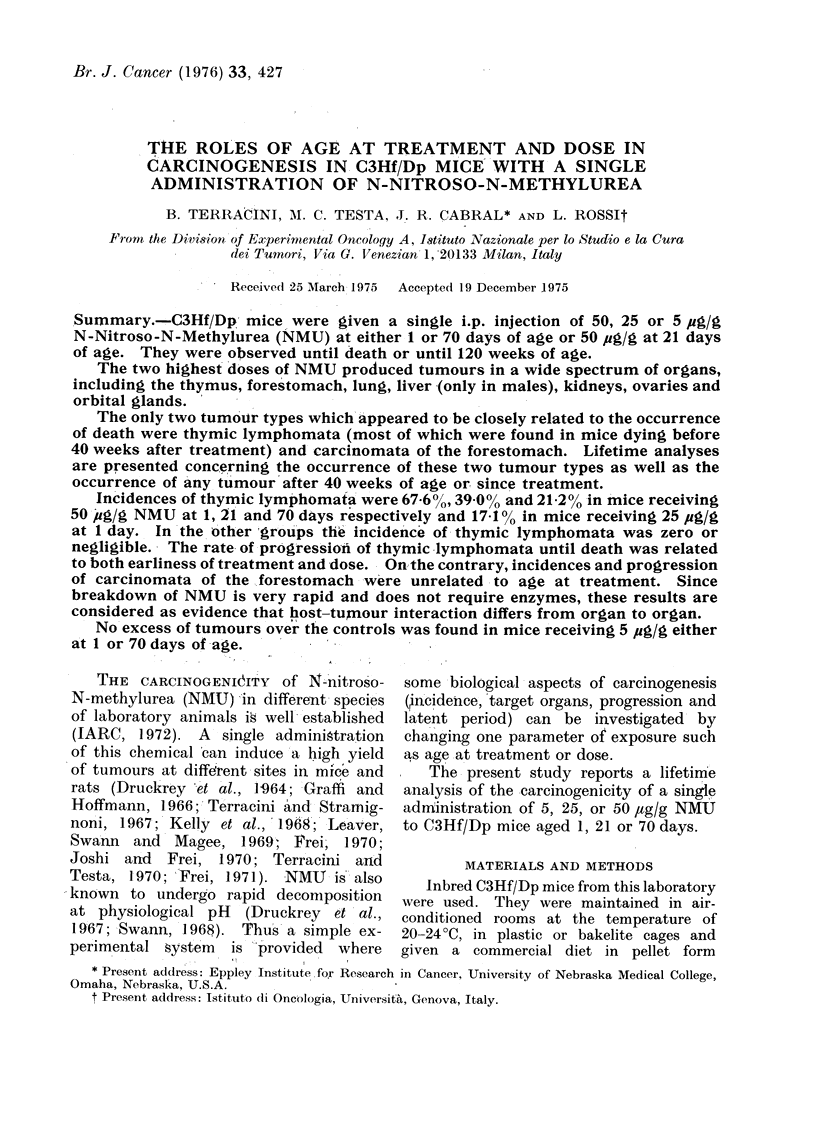
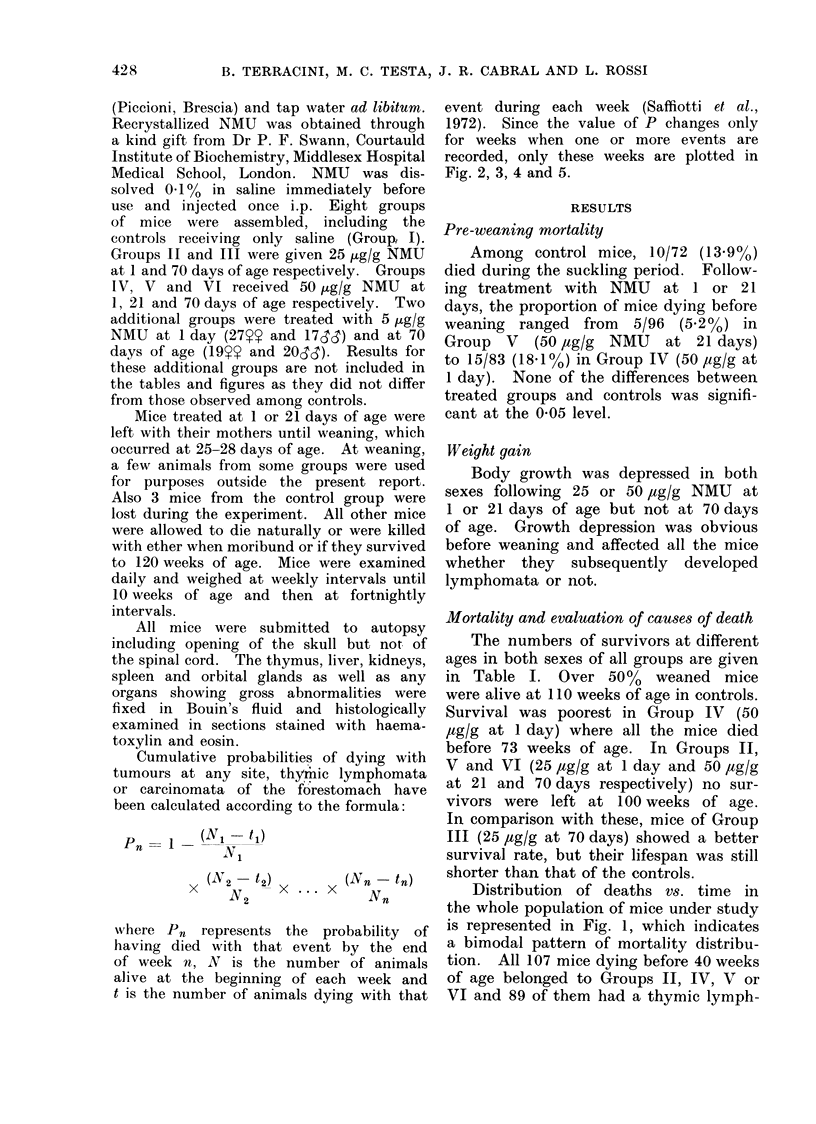




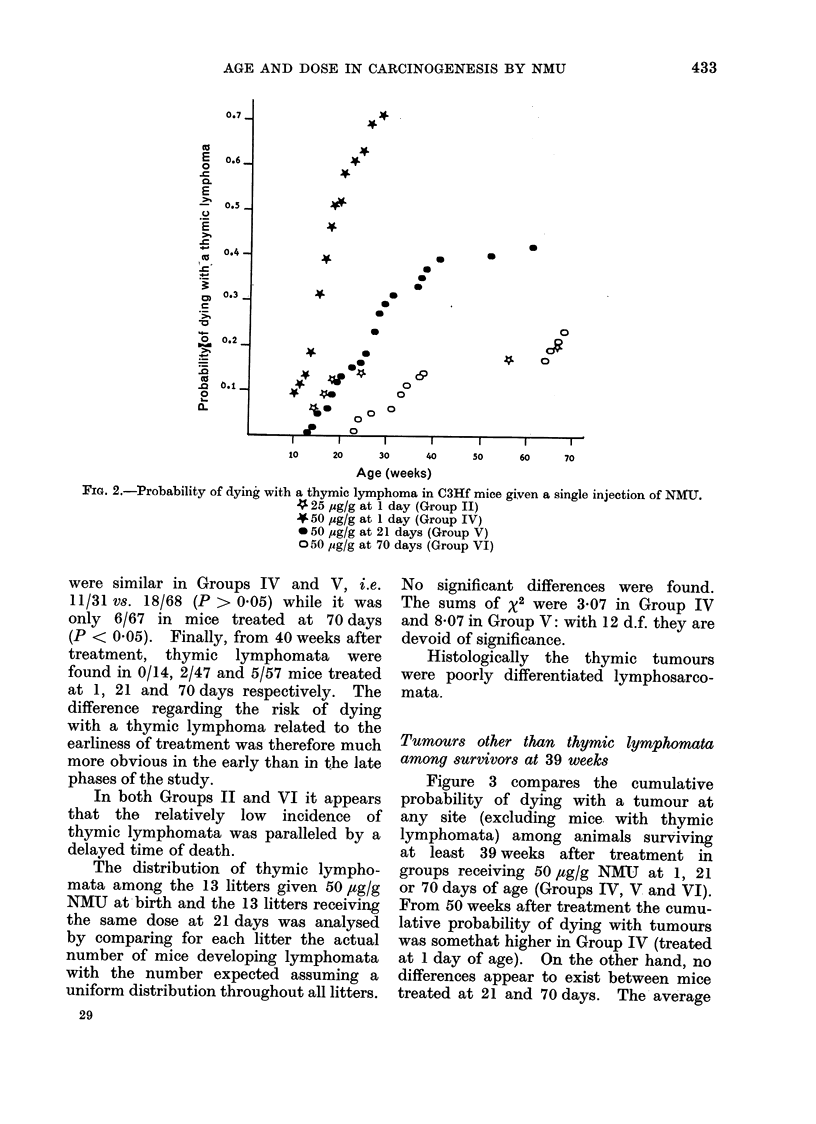
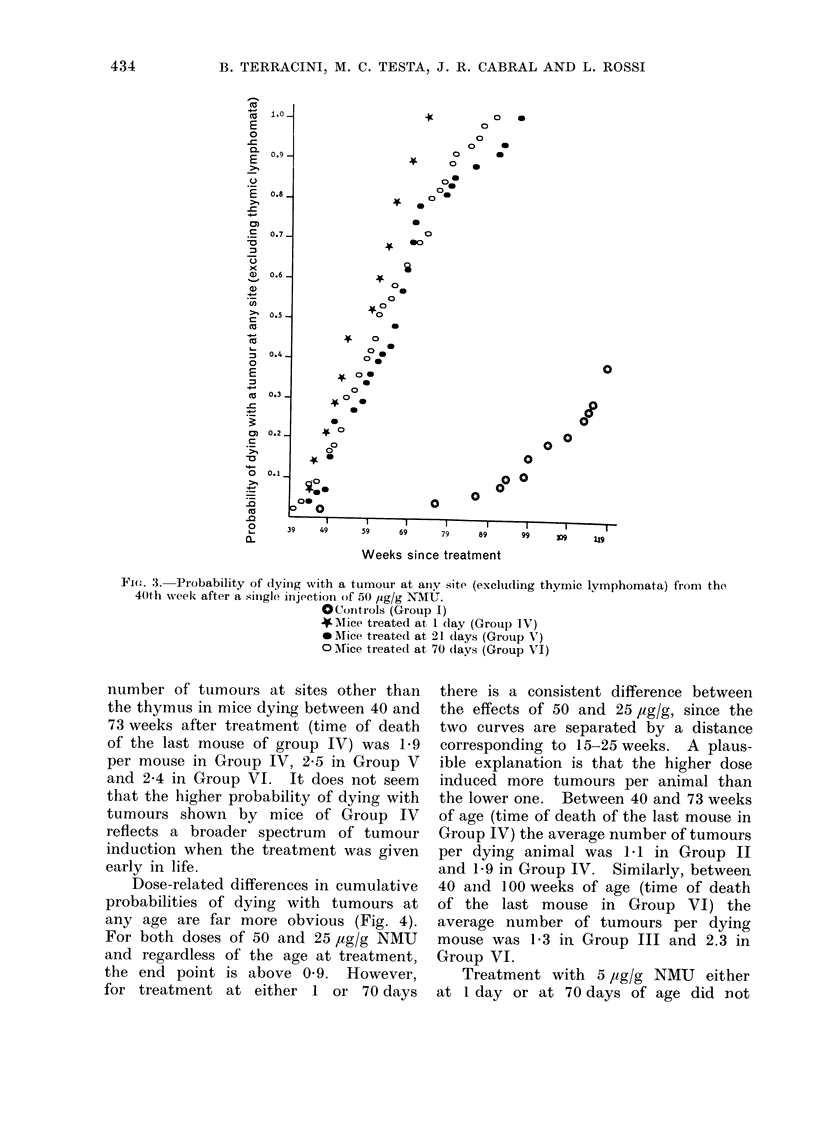
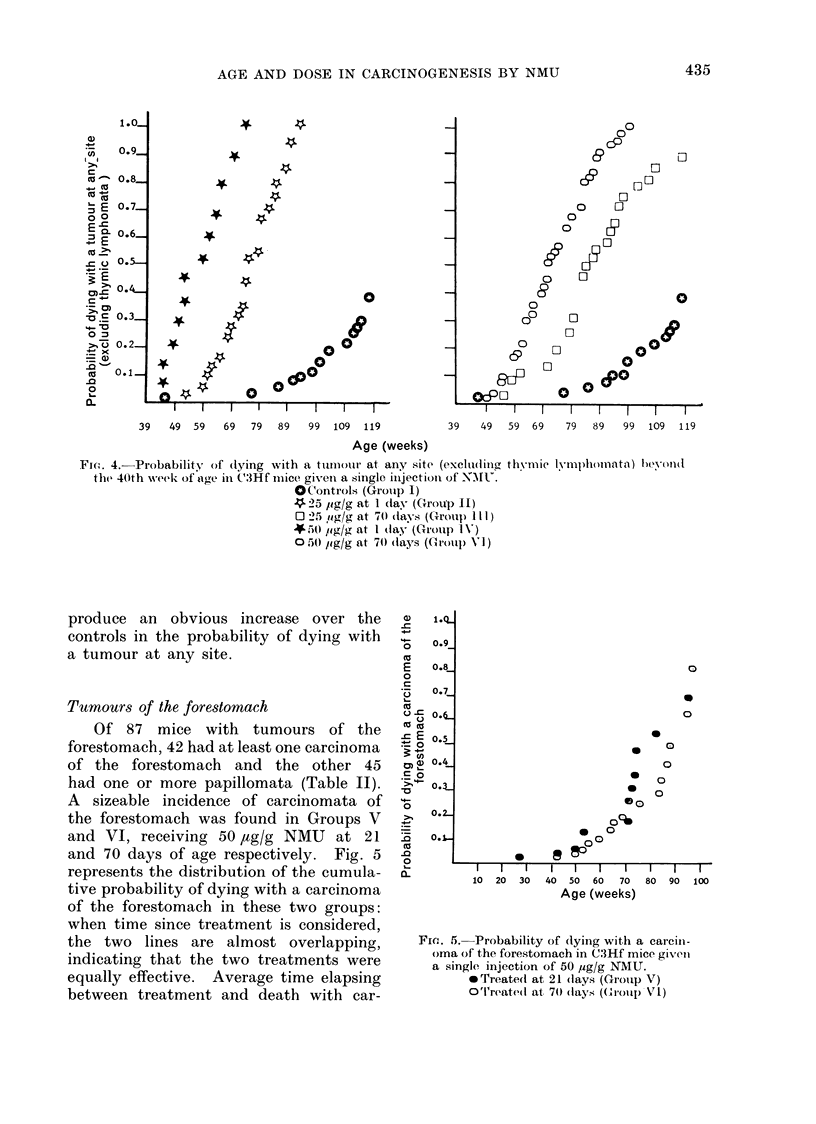

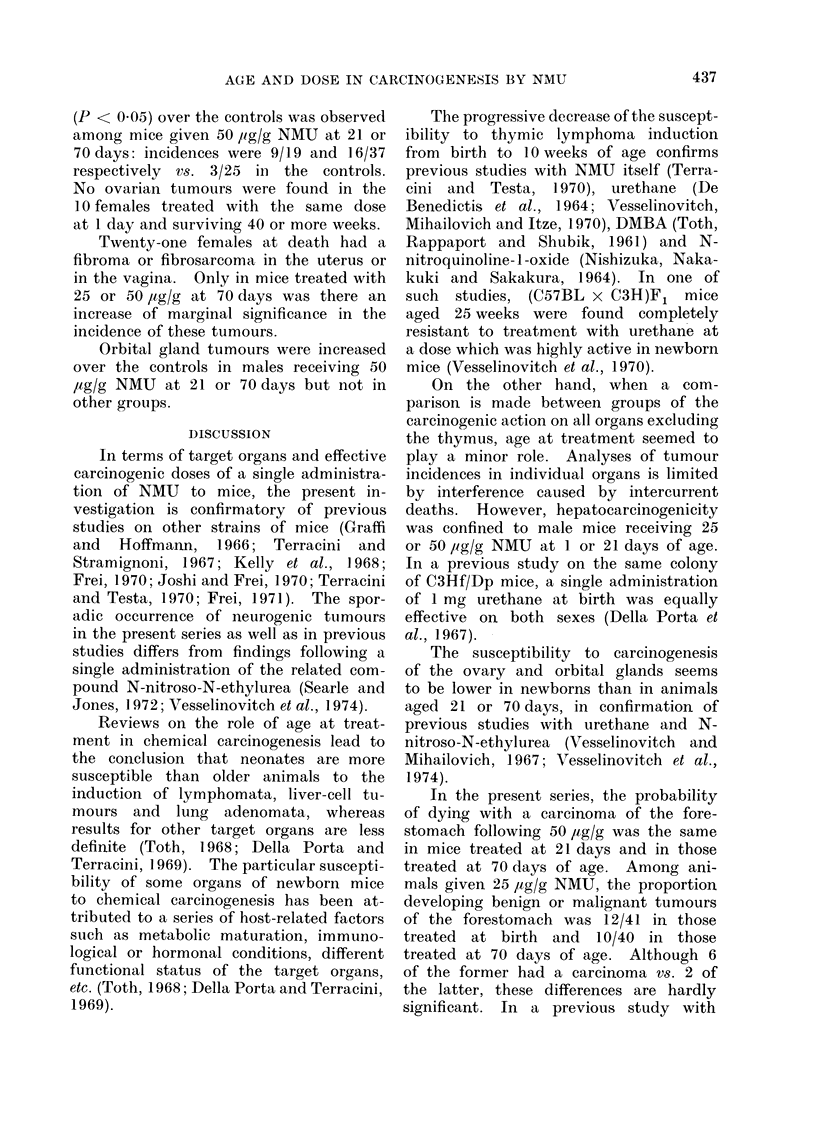
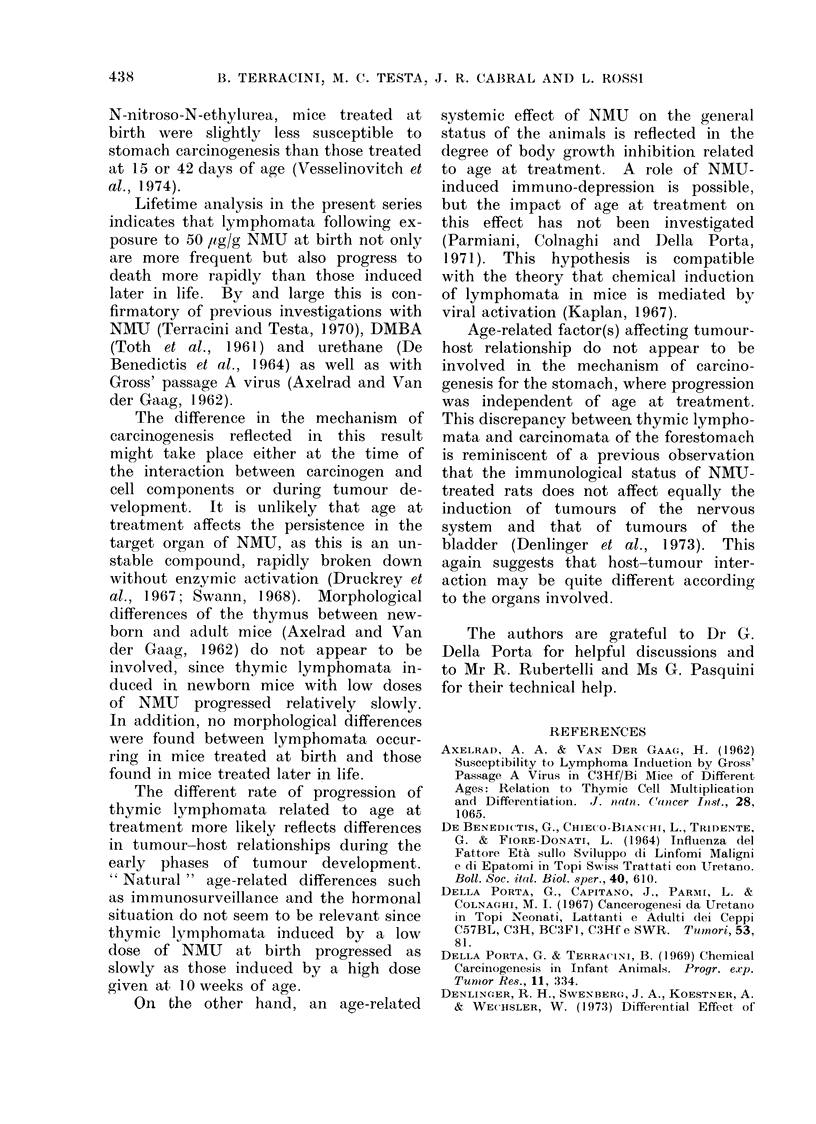
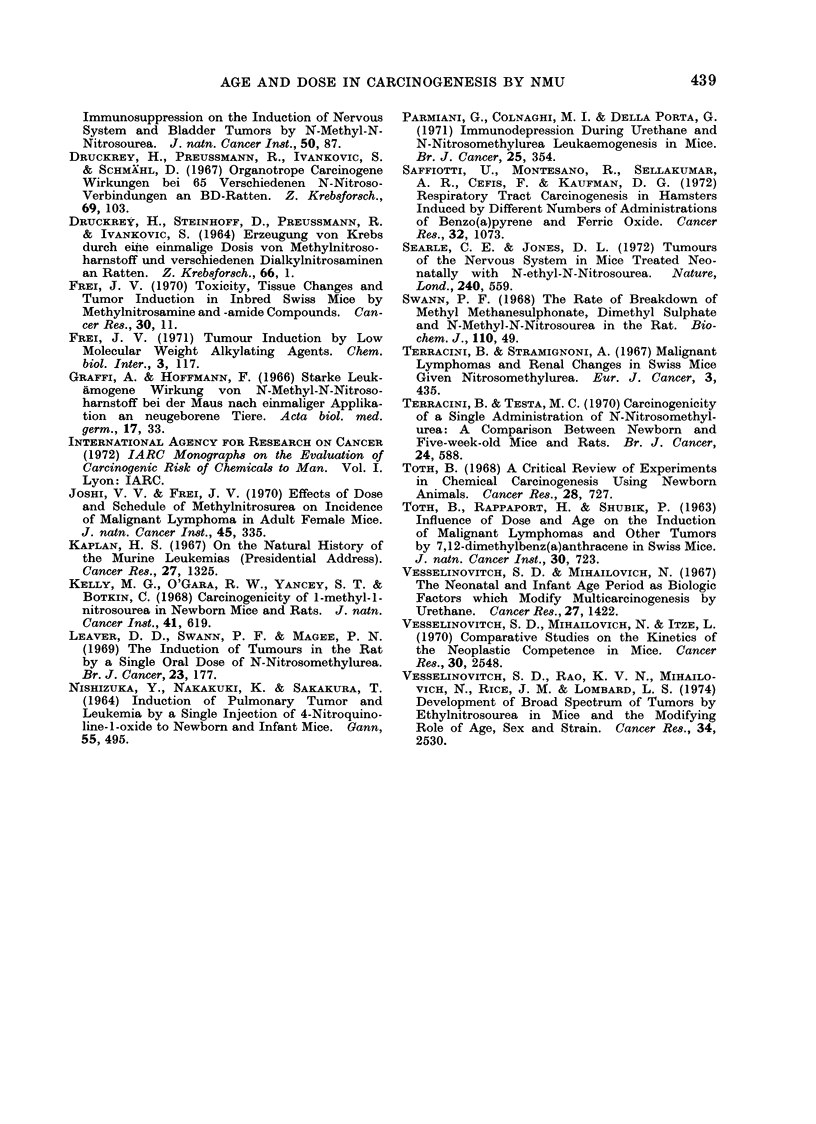
Selected References
These references are in PubMed. This may not be the complete list of references from this article.
- AXELRAD A. A., VAN DER GAAG H. C. Susceptibility of lymphoma induction by gross' passage A virus in C3Hf/Bi mice of different ages: relation to thymic cell multiplication and differentiation. J Natl Cancer Inst. 1962 May;28:1065–1093. [PubMed] [Google Scholar]
- DRUCKREY H., STEINHOFF D., PREUSSMANN R., IVANKOVIC S. ERZEUGUNG VON KREBS DURCH EINE EINMALIGE DOSIS VON METHYLNITROSO-HARNSTOFF UND VERSCHIEDENEN DIALKYLNITROSAMINEN AN RATTEN. Z Krebsforsch. 1964 Feb 7;66:1–10. [PubMed] [Google Scholar]
- De Benedictis G., Chieco-Bianchi L., Tridente G., Fiore-Donati L. Influenza del fattore età sullo sviluppo di linfomi maligni e di epatomi in topi Swiss trattati con uretano (etil carbamato) Boll Soc Ital Biol Sper. 1964 Jun 15;40(11):610–612. [PubMed] [Google Scholar]
- Della Porta G., Capitano J., Parmi L., Colnaghi M. I. Cancerogenesi da uretano in topi neonati, lattanti e adulti dei ceppi C57BL, C3H, BC3F1, C3Hf e swr. Tumori. 1967 Mar-Apr;53(2):81–102. doi: 10.1177/030089166705300201. [DOI] [PubMed] [Google Scholar]
- Della Porta G., Terracini B. Chemical carcinogenesis in infant animals. Prog Exp Tumor Res. 1969;11:334–363. doi: 10.1159/000391401. [DOI] [PubMed] [Google Scholar]
- Denlinger R. H., Swenberg J. A., Koestner A., Wechsler W. Differential effect of immunosuppression on the induction of nervous system and bladder tumors by N-methyl N-nitrosourea. J Natl Cancer Inst. 1973 Jan;50(1):87–93. doi: 10.1093/jnci/50.1.87. [DOI] [PubMed] [Google Scholar]
- Druckrey H., Preussmann R., Ivankovic S., Schmähl D. Organotrope carcinogene Wirkungen bei 65 verschiedenen N-Nitroso-Verbindungen an BD-Ratten. Z Krebsforsch. 1967;69(2):103–201. [PubMed] [Google Scholar]
- Frei J. V. Toxicity, tissue changes, and tumor induction in inbred Swiss mice by methylnitrosamine and -amide compounds. Cancer Res. 1970 Jan;30(1):11–17. [PubMed] [Google Scholar]
- Frei J. V. Tumour induction by low molecular weight alkylating agents. Chem Biol Interact. 1971 Apr;3(2):117–121. doi: 10.1016/0009-2797(71)90091-3. [DOI] [PubMed] [Google Scholar]
- Joshi V. V., Frei J. V. Effects of dose and schedule of methylnitrosourea on incidence of malignant lymphoma in adult female mice. J Natl Cancer Inst. 1970 Aug;45(2):335–339. [PubMed] [Google Scholar]
- Kaplan H. S. On the natural history of the murine leukemias: presidential address. Cancer Res. 1967 Aug;27(8):1325–1340. [PubMed] [Google Scholar]
- Kelly M. G., O'Gara R. W., Yancey S. T., Botkin C. Carcinogenicity of 1-methyl-1-nitrosourea in newborn mice and rats. J Natl Cancer Inst. 1968 Sep;41(3):619–626. [PubMed] [Google Scholar]
- Leaver D. D., Swann P. F., Magee P. N. The induction of tumours in the rat by a single oral dose of N-nitrosomethylurea. Br J Cancer. 1969 Mar;23(1):177–187. doi: 10.1038/bjc.1969.26. [DOI] [PMC free article] [PubMed] [Google Scholar]
- NISHIZUKA Y., NAKAKUKI K., SAKAKURA T. INDUCTION OF PULMONARY TUMOR AND LEUKEMIA BY A SINGLE INJECTION OF 4-NITROQUINOLINE 1-OXIDE TO NEWBORN AND INFANT MICE. Gan. 1964 Dec;55:495–508. [PubMed] [Google Scholar]
- Parmiani G., Colnaghi M. I., Della Porta G. Immunodepression during urethane and N-nitrosomethylurea leukaemogenesis in mice. Br J Cancer. 1971 Jun;25(2):354–364. doi: 10.1038/bjc.1971.46. [DOI] [PMC free article] [PubMed] [Google Scholar]
- Saffiotti U., Montesano R., Sellakumar A. R., Cefis F., Kaufman D. G. Respiratory tract carcinogenesis in hamsters induced by different numbers of administrations of benzo(a)pyrene and ferric oxide. Cancer Res. 1972 May;32(5):1073–1081. [PubMed] [Google Scholar]
- Searle C. E., Jones E. L. Tumours of the nervous system in mice treated neonatally with N-ethyl-N-nitrosourea. Nature. 1972 Dec 29;240(5383):559–560. doi: 10.1038/240559a0. [DOI] [PubMed] [Google Scholar]
- Swann P. F. The rate of breakdown of methyl methanesulphonate, dimethyl sulphate and N-methyl-N-nitrosourea in the rat. Biochem J. 1968 Nov;110(1):49–52. doi: 10.1042/bj1100049. [DOI] [PMC free article] [PubMed] [Google Scholar]
- Terracini B., Testa M. C. Carcinogenicity of a single administration of N-nitrosomethylurea: a comparison between newborn and 5-week-old mice and rats. Br J Cancer. 1970 Sep;24(3):588–598. doi: 10.1038/bjc.1970.71. [DOI] [PMC free article] [PubMed] [Google Scholar]
- Toth B. A critical review of experiments in chemical carcinogensis using newborn animals. Cancer Res. 1968 Apr;28(4):727–738. [PubMed] [Google Scholar]
- Vesselinovitch S. D., Mihailovich N., Itze L. Comparative studies on the kinetics of the neoplastic competence in mice. Cancer Res. 1970 Oct;30(10):2548–2551. [PubMed] [Google Scholar]
- Vesselinovitch S. D., Mihailovich N. The neonatal and infant age periods as biologic factors which modify multicarcinogenesis by urethan. Cancer Res. 1967 Aug;27(8):1422–1429. [PubMed] [Google Scholar]
- Vesselinovitch S. D., Rao K. V., Mihailovich N., Rice J. M., Lombard L. S. Development of broad spectrum of tumors by ethylnitrosourea in mice and the modifying role of age, sex, and strain. Cancer Res. 1974 Oct;34(10):2530–2538. [PubMed] [Google Scholar]


